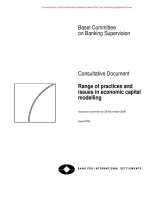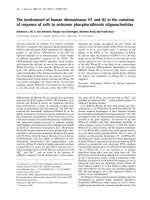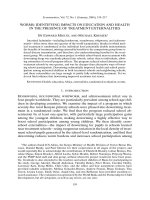Lecture Development economics - Lecture 28: Human Capital: Education and health in economic development
Bạn đang xem bản rút gọn của tài liệu. Xem và tải ngay bản đầy đủ của tài liệu tại đây (9.49 MB, 35 trang )
Human Capital: Education
and Health in Economic
Development
Lecture 28
The Central Roles of Education and
Health
• Health and education are important
objectives of development
• Health and education are also important
components of growth and development
82
Education and Health as Joint
Investments for Development
• Greater health capital may improve the
returns to investments in education
• Greater education capital may improve the
returns to investments in health
83
Improving Health and Education: Why
Increasing Incomes Is Not Sufficient
• Increases in income often do not lead to
substantial increases in investment in
children’s education and health
• Better educated mothers tend to have
healthier children
• Significant market failures in education
and health require policy action
84
Investing in Health and Education:
The Human Capital Approach
• Initial investments in health or education
lead to a stream of higher future income
85
Figure 8.1
86
Investing in Health and Education:
The Human Capital Approach
• Initial investments in health or education
lead to a stream of higher future income
• The present discounted value of this
stream of future income is compared to
the costs of the investment
87
Figure 8.2
88
Investing in Health and Education:
The Human Capital Approach
• Initial investments in health or education
lead to a stream of higher future income
• The present discounted value of this
stream of future income is compared to
the costs of the investment
• Private returns to education are high, and
may be higher than social returns
89
Table 8.1
810
The Gender Gap: Women and
Education
• Young females receive less education
than young males in nearly every LDC
811
Table 8.2
812
The Gender Gap: Women and
Education
• Young females receive less education
than young males in nearly every LDC
• Closing this educational gender gap is
economically desirable
• Consequences of gender bias in health
and education
813
Figure 8.4
814
Educational Systems and
Development
• Educational supply and demand: the
relationship between employment
opportunities and educational demands
• Social versus private benefits and costs
815
Figure 8.5
816
Educational Systems and
Development
• Educational supply and demand: the
relationship between employment
opportunities and educational demands
• Social versus private benefits and costs
• Distribution of education
817
Figure 8.6
818
Figure 8.7
819
Educational Systems and
Development
• Educational supply and demand: the
relationship between employment
opportunities and educational demands
• Social versus private benefits and costs
• Distribution of education
• Education, inequality, and poverty
820
Table 8.3
821
Educational Systems and
Development
• Educational supply and demand: the
relationship between employment
opportunities and educational demands
• Social versus private benefits and costs
• Distribution of education
• Education, inequality, and poverty
• Education, internal migration, and the
brain drain
822
Health Systems and
Development
• Measurement and distribution
823
Figure 8.8
824
Health Systems and
Development
• Measurement and distribution
• Disease burden
825









